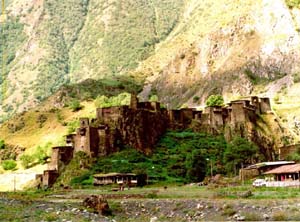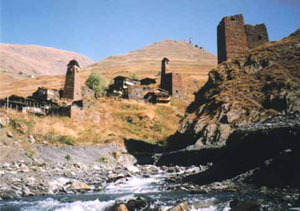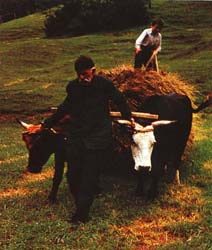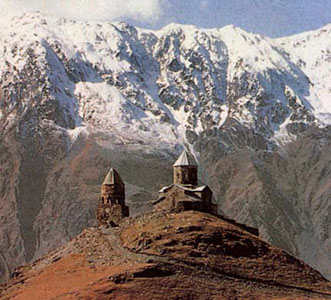Von Koba Arabuli (Tbilissi)
I. Introduction
According to the geographical data 54,4% of Georgia’s entire territory is mountainous (located higher than 1000 m above sea level), actually, if the currently widely adopted definition, which states that a ‚mountainous region is a geographic, economic and social one with the relief, climate, natural and cultural heritage, and social-economic policy which calls for the development and implementation of special rules for its development, organization and protection‘ the amount of land which would fall under this definition would be much larger.

Georgia’s mountains are divided into three major parts: Eastern, Western and Southern mountainous regions. In spite of their similarities, they differ from each other in terms of their traditions, resources and opportunities for development.
According to the established tradition 13 historical- ethnographic areas belong to the mountainous regions. In the view of the present administration-territorial division, these represent 3 major areas comprising 16 districts and 272 local (community-village) administrative units. It should be stated however, that such divisions are all very relative.
According to the historical analysis based on the census of 1926, these regions were densely populated. As is still the case today, these regions formed the country’s frontier, and one of the major missions of population here was the protection of the borders. Conditioned by the severe climate and their geographic location, making access difficult, agriculture and especially animal husbandry along with some local industry were developed. These home grown and homemade goods were remarkable for their high quality.
It should be noted that economic factors have not played any governing role in the formation of any of these historic- ethnographic regions. In each of them the form of management was created and developed independently over time, based on the analysis and mastering of the natural environment.
 High mountain historic village-fortress Shatili (XII century BC)
High mountain historic village-fortress Shatili (XII century BC)The situation (and accordingly the way of thinking) changed radically during the socialist-communist period. Abolition of private property and the „experiments“ in the economic sphere altered even the psychology of the people. The logical result is the situation that exists today: economic and social backwardness, undeveloped communication system and infrastructure, deserted regions, break-up of traditional industries, lack of specialists, insufficient qualified workers, etc.

The 80 years spent under the integrated political and economic system instituted by the soviets, and in many cases the implementation of the wrong social-economic policies under the communist regime resulted for Georgia’s mountainous regions in the following realities:
- Only 10-11% of country’s population inhabits 60% of its territory;
- Migration, caused by the severe moral and psychological strain as well as the social-political results of so-called „economic experiments“, is reaching the catastrophic point;
- The entire mechanism of economic management has been destroyed;
- Local natural, economic and intellectual resources are unused;
- The entire transport-communication and social-cultural infrastructure is out of action;
- the ecological balance has been destroyed by the barbaric attitude toward nature.
The special approach to the problems of Georgia’s mountainous regions today is guided by the following consideration:
- Increase of these regions‘ strategic, geopolitical, economic and social importance;
- Prospects of economic of social-cultural integration of these frontier regions with Georgia’s neighboring countries and their people;
- Unique historical and cultural traditions and specific ecological situation;
- Almost totally destroyed economic potential and ruined infrastructure;
- Catastrophic rate of migration.
II. Cardinal changes of the last decade and general situation within Georgia’s mountainous regions
The mountainous regions were most affected by all of the changes made in the last decade in the political, economic and social life of the country. I would like to stress that all of these changes increased the disproportion that traditionally existed. It could be mentioned here, that the major problems which were revealed (including those identified in our surveys ), do not differ substantially from the general problems of mountainous regions defined at international forums (Rio-92, Toulouse -96). These problems are as follows:
I. Increasing migration is the general problem of the mountainous regions
- The analysis of the reasons provides an almost identical picture:
- Traditionally hard work and low income;
- Unemployment, lack of job opportunities;
- Better pay in the lowlands;
- Undeveloped service and cultural sectors.
 Racha – Ancient working conditions make life more complicated in mountainous regions
Racha – Ancient working conditions make life more complicated in mountainous regions- Despoliation of nature, pollution;
- Animal husbandry and farming crisis;
- Excessive exploitation of the soil.
It is necessary to consider the causes of these problems:
- Lack of attention to regional problems by political and administrative bodies;
- Uneven distribution of financial resources;
- Weakness of internal networks
In present-day Georgia, when speaking about the peculiarities of the mountainous regions , a different group of issues emerges. Each of them requires special analysis and corresponding management:
1. GEOPOLITICAL ISSUES: The absolute majority of the mountainous regions represent the frontier line of the independent state. Consequently, their political, economic and social significance is obvious;
2. SOCIAL ISSUES: The population of the region represents historically organized ethnical groups, which, in spite of basic unanimity , clearly differ from each other;
3. ECONOMIC ISSUES: For decades the regions rich in natural resources were considered only as a source of raw materials. Others, because of unfavorable natural, geographic and climatic conditions were deemed unsuitable for development. as a result no attention was paid to the improvement of the local infrastructure.
At the same time it should be noted that the prospects for mountainous regions are defined by general requirements setting forth a concept for sustainable development (UN-Rio-92 Agenda 21). These areas are regarded as the civilized world’s achievement and the mechanism for the protection of the planet’s ecosystem for the next five decades.
 Svaneti – The highest living mountain area in Europe (2000m and more above the sea level)
Svaneti – The highest living mountain area in Europe (2000m and more above the sea level)- Lack of usable areas for farming;
- Treated areas are small in size, are scattered and have steep slopes;
- Because of severe climate and unfavorable soil conditions very low crop yield and scarcity of commodity output;
- Difficulties in utilizing mechanical equipment in agriculture and low level of labor productivity;
- Unfavorable conditions for industrial development;
- Difficulties in creating of transportation links;
- The low level of production results in the poor utilization of the labor resources and leads to the intensive migration of local population.
The peculiarities of the natural conditions of the mountainous regions cause the distinctive ways the available land is utilized:
- Disproportionate distribution of land in farming areas, resulting in lack of arable land and an excess of pastures;
- Almost total absence of areas growing perennial plants;
- Large areas of land are not arable.
A second disproportion should also be noted in the division of the land: the natural forage reserve is represented only by the summer pastures and by meadows producing hay and there are no winter pastures at all. The lack of forage resources for the winter is the major obstacle for the development of animal husbandry.
Unfavorable geographic location for a transportation system should be named as a major factor greatly influencing the economic development of the mountainous regions, as becomes apparent in the following:
- The regions are located in the border areas of Georgia, distant from the major transportation links and industrial centers;
- The regions are surrounded by natural barriers, which do not allow the development of transportation links in all direction .As a rule, the regions have one or two transportation link, which follow the river gorge;
- Due to the complex natural elevation of the roads and country’s low economic potential, most of the roads have been built with poor quality pavement and are in bad condition. This makes them seasonal, meaning that for 6 months number of the year some regions are cut from the rest of the country.
 Gergeti Convent – Christian history of Georgia is remained on the top of the mountain in this way (VIII century BC)
Gergeti Convent – Christian history of Georgia is remained on the top of the mountain in this way (VIII century BC)A very general analysis for the mountainous regions reveals the following usage of the land:
- Agricultural lands- 23,7% of the whole territory;
- Arable land -7,2%;
- Perennial cultivated plants – 1,8%
- Pastures – 14,7%;
- Forests and shrubbery- 59%;
- Non-arable lands – 17,3%
Analysis of the current conditions in Georgia’s internal market, considered together with the goal of improving agriculture productively in the mountainous regions, leads to the following general recommendation.
The volume of both general and commodity production should be increased;
The quality of the products should be radically improved;
The assortment and packaging should be redesigned to make the products more competitive both the local and foreign market;
The indicators of effectiveness should be raised. First and foremost, there should be an increase the productivity of the labor force and reduction in the prices of the products.
Koba Arabuli.
Head of The Intercultural Communications (Tourism) Center,
Tbilisi Ilia ChavChavadze State University of Language and Culture
